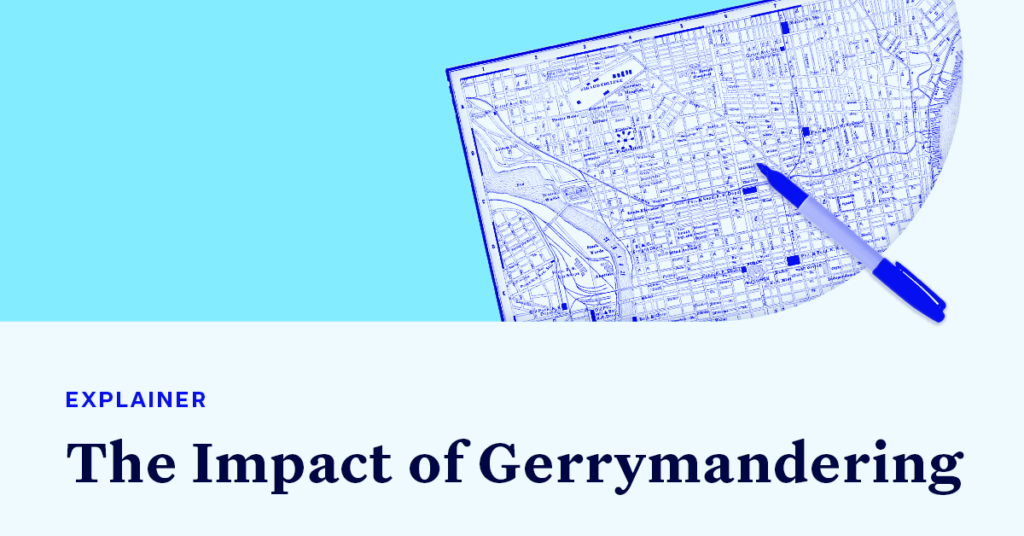Redistricting 101: How Politicians Choose Their Voters

To understand exactly how redistricting can disenfranchise thousands of voters, you need to learn about “vote dilution.” Vote dilution is the phenomenon in which one vote has less of an impact on the outcome of an election than another because of the way districts are drawn. While vote dilution manifests in many different ways, it most commonly takes two forms. First, a district map can be “malapportioned,” meaning that some districts contain larger populations than others. Malapportioned maps can violate the Equal Protection Clause’s one person, one vote rule. Second, a district map can cause “minority vote dilution,” which unfairly impedes members of a minority group from electing their preferred candidates.
One Person, One Vote
The one person, one vote rule is most commonly known for its requirement that states draw maps placing roughly the same number of people in each district. Imagine District A in a state legislature contains 100 people and District B contains 10,000 people — but each district only gets one representative. Under those circumstances, a District B resident’s vote is diluted because it has significantly less impact on the election’s outcome than a vote cast by a resident of District A. Courts often use the term weight when referring to this phenomenon — in this scenario, votes cast in District A carry significantly more weight than votes cast in District B. As the U.S. Supreme Court has explained, by requiring districts to have roughly the same population, the one person, one vote rule ensures “that the vote of any citizen is approximately equal in weight to that of any other citizen in the State.”
Congressional districts and state legislative districts are held to different standards of population equality. When a state redraws its legislative districts after a new census, each district need not have the exact same population. So long as the difference between the most populated and least populated districts is less than 10% of the average district size, the plan will likely pass constitutional muster. By contrast, when a state draws new congressional district lines, each district normally must have the same exact population.
The one person, one vote rule separately prohibits states from running their elections for statewide officials in the way that we elect the president of the United States. A state may not, for example, require statewide candidates to win a majority of the state’s counties, even if those counties are equal in population. As many critics of the Electoral College complain, such a system results in widespread vote dilution: A person’s vote matters only if they live in a county where the race is close. If the voter’s preferred candidate loses in their county, their vote is essentially canceled. And, if their preferred candidate wins their county in a landslide, their vote is wasted. (In case you were wondering, the one person, one vote rule does not apply to the Electoral College because the Equal Protection Clause applies only to the states.)
Minority Vote Dilution
Even if a map complies with the one person, one vote rule, it can still dilute the voting strength of minority groups. This can happen if a state’s residents engage in “racially polarized voting,” meaning the members of a minority group routinely vote for a different candidate than the members of the majority. In such circumstances, district lines can be drawn in a way that prevent a minority group from electing any of its preferred candidates, even when the minority group represents a significant portion of the state’s voting population.
The following illustrations depict how this can happen. Imagine a state that has 100 voters and five districts. 40 of the state’s voters are a part of a racial minority group, and 60 are in the white majority. In Map A, members of the minority group are able to elect their preferred candidates to two of the five seats, reflecting their proportion of the population. In Map B, members of the minority group can elect a preferred candidate to just one seat. In Map C, members of the minority group — despite constituting 40% of the voting population — cannot elect their preferred candidates to any seats.


The Voting Rights Act (VRA) makes it illegal for states and local jurisdictions to use maps that deny a minority group an equal opportunity to elect their preferred candidates. That prohibition applies regardless of whether the drawers of the map intended to discriminate against the minority group. The VRA can be a strong protection against racial discrimination — but Republicans can still use partisan gerrymandering to effectively disenfranchise Black and brown voters in their states. Without this firewall, redistricting resulting in vote dilution can disproportionately disenfranchise minority voters.